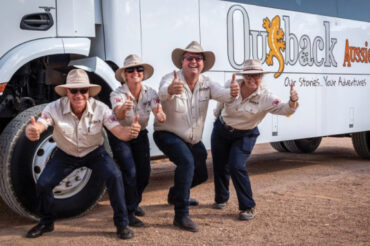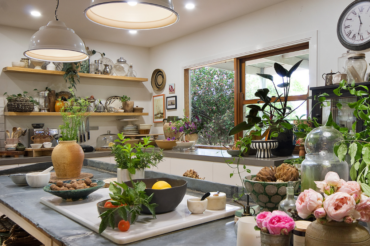
Alan (Smithy) Smith can barely contain his excitement. He’s been showing Australian Country around the paddocks of Rosebank station where he lives with his wife, Sue.
Suddenly he hits the brakes as he’s spotted an unfamiliar plant in the lee of one of the tussocks of Mitchell grass that make the sprawling plains around Longreach in central-western Queensland such great country for sheep and cattle. The plant may not look like much, but it’s enough to have Alan bouncing about like a kid in a chocolate shop. He grabs his phone to record the discovery, breaks off a sprig, crushes it and proffers it for smelling. “It’s native thyme,” he whispers. “I’ve lived on Rosebank for seven years and this is the first time I’ve seen it here.” Alan and Sue are the owners of Longreach-based tour company Outback Aussie Tours.
They show visitors around their home country with day trips by bus around Longreach and Winton, boat cruises on the Thomson River, camp-oven dinners on the riverbank and, most recently, rail trips on a vintage railmotor. Their company also provides longer packages to the Gulf, Cape York, Birdsville and the Corner Country.
The reason for Alan’s elation is not just that he’s passionate about everything he does, but also because he’s keen to include more Indigenous history and culture in the tours. “Incorporating native ingredients into our menus is part of that,” he explains. “We want to include more information about the traditional owners of this area, the Iningai people, and using bush tucker is part of that. If we can grow native thyme and other plants, we can incorporate them in the damper and other dishes we serve our guests.”
A visit to Rosebank is one of Outback Aussie Tours most popular offerings, with an interpretative tour of the property, where Alan notes the lightly timbered floodplain of the Thomson River and the channels of the Wellshot and Elibank Creeks, where coolibah, gidyea, boree, dogwood and creek wilga grow and provide shade for livestock and feed and shelter for wildlife. He explains the medicinal and practical uses of the various plants for the traditional owners and how the Mitchell grass is also known as “miracle grass” for its ability to lie dormant in a drought and rejuvenate after rain thanks to its secondary root system.

At 17,000 acres (almost 7000 hectares), Rosebank, until recently, has been part of an aggregation of land owned by the now-defunct Longreach Pastoral College. The homestead, which the Smiths lease, is now owned by a local agricultural family from Boulia and Winton, and Alan notes that it’s great to see the land being prepared for restocking. “We had seven inches [178mm] of rain last year in January and April,” he says. “The fences were just annihilated, so they are getting stuck into it. It will be great to see the land productive again.”
He pauses to point out the prolific birdlife and wallabies and kangaroos that live in the paddocks as well as the boree tree, the roots of which provided the Iningai with the raw material for spears. “This property is dependent on rain to fill the dams as the sub-artesian water here is salty and not good for stock,” Alan explains. “There are six good dams on the place and they are all interconnected with poly pipe.
Evaporation is the enemy during the long, hot summers, so water management is paramount.”Back at the homestead, Sue greets us with “smoko”, allegedly morning tea, but in fact more like lunch, with zucchini slice, sandwiches, that signature bush snack of cheese and tomato on SAO crackers, chocolate cake, Anzac biscuits and bottomless tea and coffee. As she shows visitors around the sprawling homestead, she explains that the property was originally a wedding gift of 3000 acres (1214 hectares) from Thomas Spence on the marriage of his daughter Rose Ann to James MacKenzie, who had migrated from the Scottish highlands in 1889. Although James was only 17 when he arrived in Australia, he was a go-getter, and first worked as a sawmiller on the coast until he headed to the Mount Morgan goldfields to try his luck. He came to western Queensland as a tank (dam) sinker, met Rose and applied his considerable work ethic to developing Rosebank. Sadly, the first homestead built on the property burnt down, so the MacKenzies constructed the present homestead in 1916 and it was extended to the current five bedrooms in 1923.
The MacKenzies were enterprising in their approach to agriculture as they formed a partnership with the Smith family (no relation to Alan and Sue) to farm four properties collectively. “They owned the land individually, but ran the livestock as a company,” Alan explains. “That meant if one station was in drought, they could move the sheep and cattle to another station that was having a better season.” In its heyday, the collective ran between 60,000 and 70,000 sheep, cattle for meat and surplus sale, and bred stock horses for station work and sale to other stations. The MacKenzie and Smith partnership continued until 1979, when Rosebank moved through other hands, until being run by the Department of Primary Industries as a research station and eventually turned into a training ground for budding station workers at the pastoral college.
“Because the house had been unoccupied for years when we arrived in 2016, it was covered in dust and full of detritus,” Sue says. “We moved eight truckloads of dead garden out before we could move in with our four kids.”

As Sue walks through the homestead, she points to the portrait of the original MacKenzies that hangs on the shellacked walls of the dining room, and the grand 1950s refurbishment that was added in a flurry of excitement when the homestead hosted the then newly crowned Queen’s cousin Princess Alexandra during her tour of regional Queensland to celebrate the state’s centenary in 1959. The bathroom, complete with a freestanding vanity, flushing toilet and commodious bathtub, was installed for the royal guest.
“Actually, Rosebank hosted two members of the royal family that year, as before Princess Alexandra came, there was a visit from Princess Alice, the Countess of Athlone,” Sue says. “She was the mother of Princess May of Teck, or Lady May, who was married to the then Governor of Queensland, Sir Henry Abel-Smith. We understand she was here visiting with her daughter’s family.”
Alan grew up in the Blackall district of central-western Queensland, where his relatives were butchers, and then ran a soft-drink factory. “My mother, Trethella Mossman, came from the Boyne Valley near Gladstone,” Alan explains. “She was sent out to the west because she suffered from asthma and the dry weather was thought to be better for her condition. She went to the butcher shop to buy steak, met my dad and the rest was history. We had family who owned Valpraiso station, and my uncle was a huge inspiration to me as he taught me so much about the land and its flora and fauna and Aboriginal
art sites and history.”
Alan went to Brisbane after school where he worked in hospitality, then door-to-door selling, before he travelled around Australia in 1986-’87. “That was when I realised the potential of a tour company,” he says. “I came home in 1988 and started tag-along tours. Later that year, the 21-year-old bought his first troop carrier and registered Outback Aussie Tours. In those early days, an old family friend took Smithy bush and taught him how to make damper in a Bedourie oven. Today, Alan proudly shows us a scrapbook containing the hand-written recipe, which remains one of the hallmarks of the company’s hospitality. In 1990, Alan bought his first Coaster bus, and Sue, who was on a gap year before she went to agricultural college, arrived in the district. The couple have been working shoulder to shoulder on their business ever since, and it’s the hands-on nature of their operation that makes it such a standout. It’s not uncommon for Sue to meet and greet guests at their camp-oven dinners or for Smithy to be holding the mic sharing his boundless enthusiasm for the state and region with their guests. The Smiths’ now-adult children, Isabella (Bella), Lachlan, Lily and Hugh, have all grown up around the business and Bella is currently
in charge of day tours for the company.
“We’ve come a long way since the days when I’d jump on the train at Ilfracombe and hand out home-made flyers urging passengers to take a tour as the train headed for Longreach,” Smithy says. “We used to be able to take seven people in the troopie, and last year we hosted 11,000 guests, but the essence of what we do remains the same. We just want to welcome people to our neck of the woods and share genuine bush hospitality.”
For many guests, a morning at Rosebank is a real highlight, a chance for city visitors to gain insight into the way stations are run and a lifestyle where community is everything and neighbours are more like relatives than people you nod to in passing. Often guests don’t want to leave the cool of the verandah and the warmth of their hosts’ reception.
“That’s the spell of Rosebank,” Smithy says. “Once you sit down, you don’t want to get up again. To fully appreciate the outback, you’ve got to slow down. It’s the ultimate stress reliever.”
Photography Ken Brass










